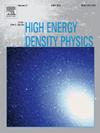离子加速与强短脉冲激光和大面积悬浮石墨烯在极薄靶区
IF 0.9
3区 物理与天体物理
Q3 PHYSICS, FLUIDS & PLASMAS
引用次数: 0
摘要
石墨烯是一种原子薄型二维材料,被称为二维材料中强度最高的材料。目前已开发出用于激光驱动离子加速的独立大面积悬浮石墨烯(LSG)。这种石墨烯在激光预脉冲面前表现出了非凡的耐久性,可以在没有等离子镜的情况下通过强激光直接照射产生兆电子伏的质子和碳,但却没有进行相关的优化。在此,我们研究了利用 LSG 进行激光驱动离子加速的优化问题,并特别关注了目标条件。我们用强激光辐照纳米厚的 LSG,入射角和目标厚度都是可控的。质子的最大能量随着 LSG 层数的增加而增加,其中 25±0.3MeV 质子的最大能量可通过汤姆逊抛物线光谱仪和基于钻石的探测器持续观测到。为了进行比较,我们在不考虑预脉冲的情况下使用粒子在胞(PIC)代码进行了理想的数值模拟。在 PIC 模拟中,质子先后被与激光辐射压力和表面鞘场相关的电场加速,但最大质子能量被高估了。实验得出的最大质子能量逐渐接近理想的 PIC 预期值,这表明较薄的 LSG 受预脉冲的影响更大。我们期望在优化的 LSG 条件和等离子镜下获得更高的质子能量。本文章由计算机程序翻译,如有差异,请以英文原文为准。
Ion acceleration with an intense short-pulse laser and large-area suspended graphene in an extremely thin target regime
Graphene is an atomic thin 2D material, known as the strongest material with such a thin regime. Free-standing, large-area suspended graphene (LSG) has been developed for a target of laser-driven ion acceleration. The LSG has shown remarkable durability against laser prepulse, producing MeV protons and carbons by direct irradiation with an intense laser without a plasma mirror, yet no optimization has been concerned. Here we investigate the optimization of the laser-driven ion acceleration with LSG, paying special attention to the target conditions. We irradiate nanometer-thick LSG with an intense laser, where the incident angle and the target thickness are controlled. The maximum proton energy increases with increasing the number of LSG layers, where protons at maximum are consistently observed with Thomson parabola spectrometer and diamond-based detectors. For comparison purposes, we perform ideal numerical simulations using particle-in-cell (PIC) code without consideration of the prepulse. In the PIC simulation, the protons are successively accelerated by the electric field associated with laser radiation pressure and the surface sheath field, yet the maximum proton energies are overestimated. The maximum proton energies from the experiment asymptotically approach the ideal PIC expectations, indicating that the thinner LSG is more affected by the prepulse. We expect higher proton energy with the optimized LSG conditions and a plasma mirror.
求助全文
通过发布文献求助,成功后即可免费获取论文全文。
去求助
来源期刊

High Energy Density Physics
PHYSICS, FLUIDS & PLASMAS-
CiteScore
4.20
自引率
6.20%
发文量
13
审稿时长
6-12 weeks
期刊介绍:
High Energy Density Physics is an international journal covering original experimental and related theoretical work studying the physics of matter and radiation under extreme conditions. ''High energy density'' is understood to be an energy density exceeding about 1011 J/m3. The editors and the publisher are committed to provide this fast-growing community with a dedicated high quality channel to distribute their original findings.
Papers suitable for publication in this journal cover topics in both the warm and hot dense matter regimes, such as laboratory studies relevant to non-LTE kinetics at extreme conditions, planetary interiors, astrophysical phenomena, inertial fusion and includes studies of, for example, material properties and both stable and unstable hydrodynamics. Developments in associated theoretical areas, for example the modelling of strongly coupled, partially degenerate and relativistic plasmas, are also covered.
 求助内容:
求助内容: 应助结果提醒方式:
应助结果提醒方式:


